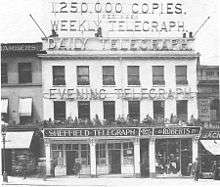Sheffield Telegraph

The Sheffield Telegraph is a weekly newspaper published in Sheffield, England. Founded in 1855 as the Sheffield Daily Telegraph, it became known as the Sheffield Telegraph in 1938.
History
The Sheffield Telegraph was founded in 1855 as the Sheffield Daily Telegraph. It was the city's first daily newspaper, published at 08:00 each morning. The newspaper struggled until W. C. Leng became editor in 1864, moving the business to Aldine Court, introducing Linotype printing and using it to support the Conservative Party.[1]
After taking over the Sheffield and Rotherham Independent in 1938, it dropped the "Daily" from its name.
The history of Sheffield's "Telegraph" is intertwined with that of The Star and the Green Un. All three newspapers are published today by Johnston Press PLC. As has been the case for its sister publications, the Telegraph has undergone several name changes during its history.

The Sheffield Daily Telegraph was first published on 8 June 1855 and continued under this name until 1934.[2]
In its early years, the newspaper was owned by Frederick Clifford and then William Leng. It aimed to popularise the Conservative Party cause among the working class. By 1898, it was claiming sales of 1,250,000 copies per week, and it had two sister publications: the Weekly Telegraph, which contained feature articles and serialised fiction, and the Evening Telegraph, which later became The Star.[3]
From 16 July 1934 to 29 October 1938 it appeared as the Sheffield Telegraph, and as the Sheffield Telegraph and Daily Independent from 31 October 1938 until 13 May 1939.
During the first years of the war (15 May 1939-12 June 1942) the newspaper was named the Telegraph & Independent, changing briefly (13 June 1942-14 July 1942) to the Sheffield Telegraph and Independent, before assuming the title Sheffield Telegraph on 15 July 1942 which it maintained until 14 September 1965.
The new title of Sheffield Morning Telegraph was implemented on 15 September 1965 and continued in use to 10 January 1966, after which Morning Telegraph was adopted (11 January 1966-8 February 1986). The Morning Telegraph ceased production in 1986.
In 1989, the Sheffield Telegraph was relaunched, and published weekly, on Fridays, and featuring a large property section. In 2010, the Sheffield Telegraph changed its day of publication from a Friday to a Thursday.
In January 2007, the total average issue readership for the Sheffield Telegraph was reported to be 64,093.[4]
Notable staff at the Telegraph have included Sir Harold Evans, who was later PRO to Prime Minister Harold Macmillan, and head of ITV News Service (not to be confused with another Harold Evans, the former editor of The Sunday Times); author Peter Tinniswood; novelists John Harris and J.L. Hodson; cartoonists Ralph Whitworth and J. F. Horrabin for the daily and Pete McKee for the weekly; critics George Linstead and E. F. Watling; sports writers John Motson, Lawrence Hunter, Peter Keeling, Peter Cooper, Frank Taylor (who later survived the Munich Air crash of 1958), and Keith Farnsworth; sub-editors Jack Westwood and Israel Panner.
Other editorial staff members have included Keith Graves, who was later with the BBC and Sky TV as a much-travelled reporter; Peter Harvey, a long-serving feature writer who was awarded the MBE in 2002; Geoffrey L. Baylis, who in later years was honoured for services to journalism in New Zealand; Barry Lloyd-Jones, Brian Stevenson and Clive Jones, who were news editors; Leslie F. Daniells and Frazer Wright were long serving industrial reporters; Alf Dow, a news editor who was later the company's first training officer, and ended his career as PRO at Newton Chambers & Co.Ltd; Richard Gregory, who became a leading figure at Yorkshire Television and was later chairman of the Yorkshire Bank; George Hopkinson; Jean Rook, who was later a women's writer with the Daily Express; and Will Wyatt.
The paper's London staff have included John Morris, who was later general secretary of the British Boxing Board of Control; Andrew (Drew) Webster; and Alan Hubbard. Graham Cawthorne was the paper's best-known Parliamentary reporter in the post-war era.
Editors
- 1855: Benson
- 1855: Pearce
- 1858: William Shepherdson
- 1864: William C. Leng
- 1902: R. H. Dunbar
- 1910: David M. Sutherland
- 1912: John Oakley
- 1937: Frederick Keith Gardiner
- 1955: Bill Lyth
- 1962: David Hopkinson
- 1964: Michael J. Finley
- 1969: Michael Hides
- 1983: Peter Darling
References
- ↑ "Leng, Sir William Christopher", Oxford Dictionary of National Biography
- ↑ British Library Integrated Catalogue
- ↑ The History of the City of Sheffield 1843-1993: Images, ed. Clyde Binfield et al.
- ↑ Joint Industry Committee for Regional Press Research (JICREG) data for 1 January 2007
"Press Gazette", 21 June 2002.
Bibliography
- Bob Horton, Living in Sheffield: 1000 years of change
- Keith Farnsworth, The Turner Story: Bringing the News to Sheffield (Henry Melland, London, 1991).